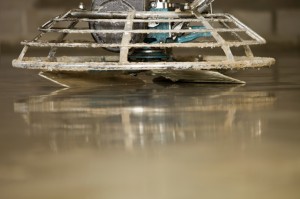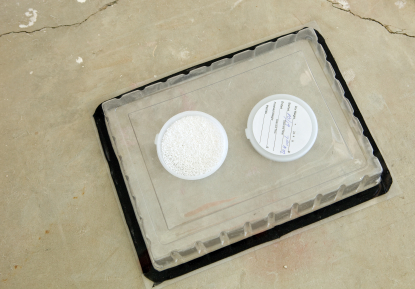Trouble with Power Troweling: Can It Taint Your Moisture Testing Results?
Correct and accurate moisture testing of a concrete slab is critical to determining when a slab has dried to the appropriate moisture level before moisture-sensitive floor coverings or coatings are installed. Even though surface testing methods are becoming less desirable for doing this testing, they are rendered even more suspect when a slab surface has been heavily power-troweled and densified, unless you ensure the surface is ground appropriately and you strictly adhere to the required 24 hour time period prior to setting the surface test.
When working on a large concrete project, power troweling does allow the ability to cover large surfaces within a relatively short amount of time. In terms of man hours and even finish options, it may seem like the smarter choice.
But if the wrong moisture test method and/or if improper or incomplete surface preparation are employed to check the moisture content of the drying slab, the results may not be as meaningful as we think.
The challenge of testing the moisture content of a concrete slab that has been power troweled is twofold: first, the slab may actually dry more slowly because of power troweling, and second, a surface-based test method may provide misleading results.
Newly poured concrete is naturally porous and this is inherently part of the drying process. The mix of aggregate, cement, and water provide the initial mix with certain characteristics that will determine the drying time of the slab. Because moisture leaves a slab from the exposed surfaces, anything that compromises that surface impacts the moisture’s ability to leave the slab in the drying process.
Think of fresh concrete as an interconnected set of pathways or capillaries that open to the surface. In a very simple explanation, the spaces between the aggregate fill with cement and water. As the water evaporates from the surface, moisture is able to move up through the mixture and in turn evaporates by whatever combination of air movement and heat are present at the surface. The equalizing of a slab’s moisture to its environment is known as equilibration and it is a continuous cycle that moves moisture out (and in, if the humidity balance tilts the other way) until the surface of the concrete is sealed.
If the slab is “over” power troweled, the ability of the moisture to move through the concrete is inhibited. One-stage power troweling increases the risk of overworking the concrete, compressing the top layer of the slab and sealing off those naturally porous vents in the surface. Sharp blade angles or high blade speed can cause the same effect by “burning” the surface of the slab. It creates, in effect, a moisture barrier on top of the concrete slab by sealing off the pathways for natural moisture migration from the surface. The moisture cannot escape the surface readily and drying time will be significantly extended.
 Unfortunately, this problem with drying time also goes hand-in-hand with the inability for certain test methods to adequately and easily reflect the true moisture conditions within the slab. Any method that depends on a surface-based measurement will also be hampered by the problems created when the slab surface is over power troweled, again, unless proper surface preparation and adequate time lapse, prior to setting the tests.
Unfortunately, this problem with drying time also goes hand-in-hand with the inability for certain test methods to adequately and easily reflect the true moisture conditions within the slab. Any method that depends on a surface-based measurement will also be hampered by the problems created when the slab surface is over power troweled, again, unless proper surface preparation and adequate time lapse, prior to setting the tests.
For example, calcium chloride (CaCl) in a small dish under a sealed ‘hood’ on a slab’s surface has routinely been used as a test method for determining moisture conditions in concrete. The method works by placing a small pre-weighed amount of CaCl or other desiccant material onto the concrete surface and then sealing it for a specified amount of time. In theory, any moisture that evaporates from the surface under the sealed area will be absorbed by the desiccant and the difference in weight can be used to calculate the rate of moisture vapor emission.
In practice, however, this cannot be an accurate indication of the moisture content within the slab, and this inaccuracy is exacerbated if the movement of moisture from the surface of the slab has been inhibited in any way, including by over power troweling.
How, then, can you know when the slab has reached a safe level of moisture for installation of the floor covering?
The ASTM F2170 test method for determining the relative humidity (RH) level within the slab using in situ probes is the most accurate method for determining moisture conditions below the troweled surface. With RH test methods, like the Rapid RH®, sensors are placed within the concrete and are inherently less susceptible to surface conditions. And it’s accuracy that counts when monitoring the readiness of a drying concrete slab.
Power troweling can mean time and labor cost savings for concrete slab installations. But if that smooth surface is concealing high moisture conditions, only RH testing will save you time, labor costs and the headache of moisture-related problems down the road.
